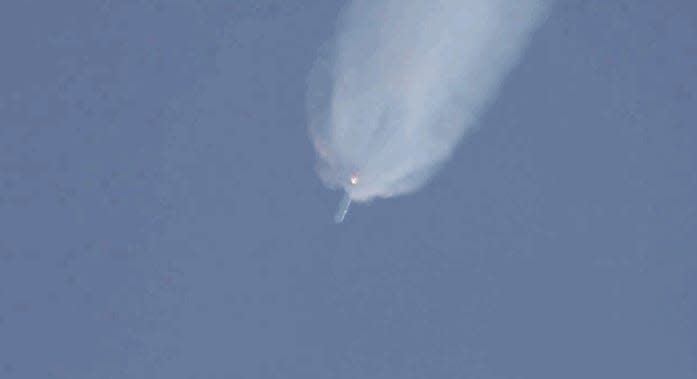SpaceX delayed its NASA astronaut launch because a red 'nail polish' material was plugging part of its rocket engines

SpaceX delayed its next astronaut mission for NASA after engine problems led it to abort a Falcon 9 rocket launch.
The culprit turned out to be a nail-polish-like substance that blocked a vent hole after a treatment by a SpaceX vendor.
If the rocket hadn't aborted its launch, there could have been an uncontrolled explosion inside the engines.
NASA is now targeting November 14 to launch Crew-1, SpaceX's first operational flight with astronauts.
SpaceX's Falcon 9 rocket has flown hundreds of satellites and two astronauts into Earth's orbit over the past two years. But on October 2, with just a few seconds to go before liftoff, a flight computer automatically shut everything down. Something was wrong with two of the vehicle's nine Merlin rocket engines.
The company's next NASA-astronaut mission — its second crewed flight to the space station — would have to wait until the issue was sorted out, instead of launching on Halloween as planned.
Workers removed the engines and shipped them to SpaceX's development facility in McGregor, Texas, for inspection. After nearly a month of testing, SpaceX finally found the culprit: Bright-red residue had clogged a valve that helps regulate the release of fuel and ignition fluid. That process requires precise timing to avoid an explosion.
The "red nail polish"-like substance was a masking lacquer, according to Hans Koenigsmann, SpaceX's vice president of flight reliability. A third-party vendor uses the lacquer to cover sensitive parts of the rocket while it applies a corrosion-resistant treatment to other areas, Koenigsmann said.
The lacquer is supposed to be removed after the treatment is done. SpaceX said it believed it got into the relief valve's tiny borehole — which is about one-sixteenth of an inch wide — when the vendor cleaned the engines.

"We could actually show that when we remove that masking lacquer from the vent hole, that the engine performed perfectly normal," Koenigsmann said in a press briefing on Wednesday.
"Rockets are humbling me every day I work with them," he later added.
If the abort programming hadn't stopped the launch, the engines may have loaded too much fuel into their combustion chambers before igniting.
Like a car backfiring, this could have resulted in an explosion that would have rattled and damaged the engines.
Koenigsmann said SpaceX discussed the issue with the vendor that applied the treatment and washed away the lacquer. But he did not disclose the name of the vendor.
"I'm pretty sure it will not happen anymore," Koenigsmann said.
SpaceX is now planning to launch its next NASA astronauts in a mission called Crew-1 on November 14.
Checking and double-checking to avoid 'dire consequences'
This isn't the first time a launch has gone awry because of issues with one of SpaceX's vendors.
In June 2015, a Falcon 9 rocket carrying a resupply cargo ship headed for the space station exploded after liftoff. The ensuing investigation found that a pressurized helium vessel came loose in flight after a substandard component on a steel rod broke free.

SpaceX CEO and founder Elon Musk said that rod came from an outside vendor, though NASA knocked SpaceX for not adequately vetting the materials.
In the case of the red masking lacquer, Koenigsmann said SpaceX didn't want to point fingers.
"This was all contained and safe. But it acts a little bit as a call to us too," he said. "We're fully aware of the dire consequences of a mistake here."
Koenigsmann said SpaceX has ensured that the engines on the rocket set to carry the Crew-1 astronauts have "clean vent holes."
"I think the fixes are relatively easy," Koenigsmann said. "It's just double making sure that everything is clean by the time you put it together."
After a mistake like this, he added, "you improve your process, you improve your vigilance, and you have a better rocket on the launchpad."
Dave Mosher contributed reporting.
Read the original article on Business Insider

